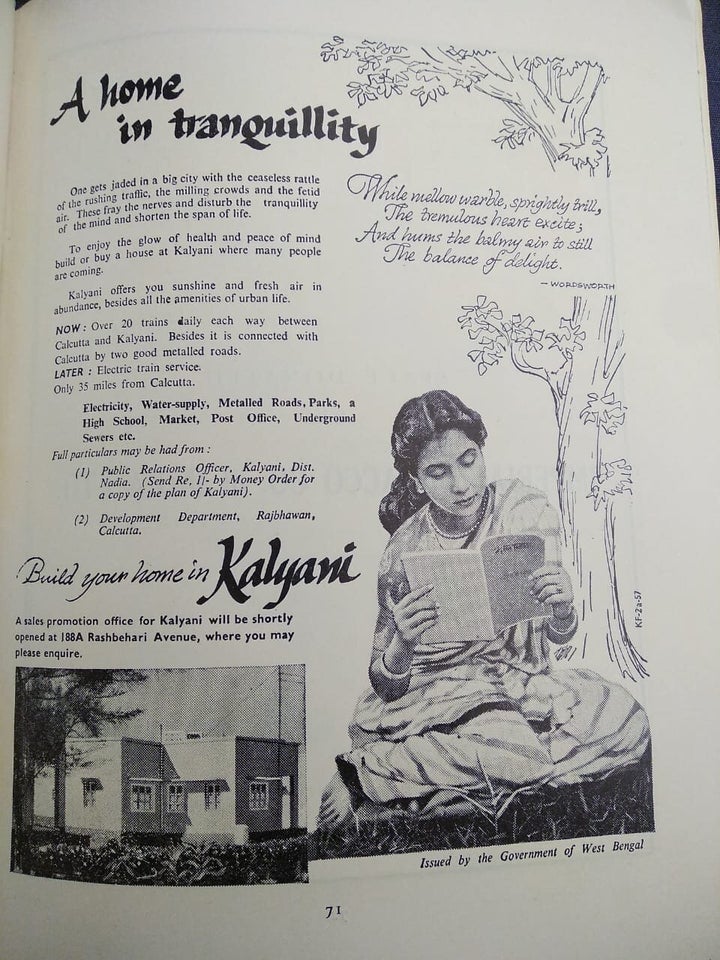
If you walk past the Kalyani Telephone Exchange, towards the Central Park with the Thana Grounds to your left, you will come across a small, nondescript building with paint peeling off its walls. This is the Kalyani Public Library, which has a magazine section, a newspaper reading room, a reference room, and a lending section that has—had, in the ’90s—exactly one bookshelf dedicated to its young readers. One evening many years ago, my aunt took me to this building and filled up the membership forms on my behalf. It was a momentous day in my young life.
Kalyani is located 50 km to the north of Kolkata, in the Nadia district of West Bengal. It’s where I was born and spent the first 15 years of my life. Our township was among the ‘new towns’ that were established in West Bengal after independence, along with now familiar names such as Durgapur, Chittaranjan, Digha, and Haldia. Imagined as a ‘garden city’ that could serve as a self-sufficient middle-class retreat and relieve Kolkata of its surplus population, Kalyani came with a university and an industrial estate with cheap commercial plots in the offering. It also came with an urban legend, that the town’s name was testimony to (then Chief Minister) Bidhan Chandra Roy’s broken heart, after having been refused the hand of Dr. Nilratan Sarkar’s youngest daughter, Kalyani. Living in the middle-class bubble that was the planned part of the town, with its wide roads, green boulevards, and playgrounds, it was easy to imagine ourselves as citizens of a model township, inhabiting the future.
It’s a different matter that said model township only had a few bookstores with a sparse collection of books, alongside assorted stationery. English books were even harder to find. My father, who travelled to Kolkata occasionally for work, would return with a couple of secondhand books—Enid Blyton’s Famous Five series, or abridged editions of classic novels—from the Mullick Book Emporium at Free School Street. On his next trip, they would be returned, and exchanged for another set. As Sumana Roy wrote in the Los Angeles Review of Books, such was the fate of the provincial reader in the ’90s, for whom everything arrived late. For those of us who knew no other life, it would become the norm, but it was one I chafed against. I prowled through the family bookshelves, and read everything I could get my hands on, from my mother’s copy of Sunil Gangopadhyay’s Bhayankar Sundar to Anil Bhowmick’s Francis Samagra and Dinesh Chandra Chattopadhyay’s Duranta Eagle. I drew my own ‘graphic novels’ after reading Roy of the Rovers in Anandamelas new and old. In the library period in school, a bunch of us would fight over the one illustrated edition of Ivanhoe and Tales from Arabian Nights. I longed for an unlimited supply of books and stories to lose myself in. The public library with its one bookshelf for young readers was not what I would have chosen for myself, but it became an important part of my life at the time.
***
In the era of Nehruvian planning, it was not surprising that the industrial logic of urban planner Ebenezer Howard’s ‘garden city’ project held appeal to administrators. Townships such as Kalyani were driven by the principle of what historian Jean-Yves Tizot calls “urbanizing and industrializing the countryside”. It took some time for the town’s attractions to draw more people to it. By 1981, the population of Kalyani had risen to 38,334 from a mere 4,616 two decades ago. The state government placed advertisements promoting the ‘tranquility’, ‘glow of health’, and ‘peace of mind’ that living in Kalyani could offer. In one such advertisement, a woman in a sari reads a book, while a Wordsworth quotation promising ‘delight’ accompanies her image.

Perhaps it was this promise of a quiet existence, far from the city after a few difficult years as a refugee in Kolkata, that drew my grandfather to the town in 1959. The option of payment at the rate of Rs 100 per month for the government-constructed house, instead of a one-time payment, proved lucrative as well (the payments eventually ended in 1983). The public library, established in 1975, was a part of the promised urban amenities of the ‘garden city’—no doubt deemed a significant requirement for the people of the growing township of the mid-70s.
Living in the planned part of Kalyani made it easy to imagine the land as a blank slate on which enterprising men like Bidhan Chandra Ray dreamed up a township of the future. The aura of the planned township made it easy to forget the deep history of the land, criss-crossed by migration and dispossession. In 1943, after a discussion between the President of the United States and the Prime Minister of the United Kingdom, people living in the inconsequential villages that made up the area were evicted with little or no compensation to make way for a camp for American soldiers, named Roosevelt Nagar. After Independence there was a second dispossession, as the government of West Bengal acquired Roosevelt Nagar and 14 other villages in the vicinity. The public library, located well within the bounds of the planned township, offered a young reader like myself no insights into this history.
There was little in the library’s sole shelf for young readers that offered other information about the place I lived in, such as the fact that there existed a Kalyani outside the bounds of the planned township—the Kalyani of the colonies. Migration and dispossession is etched into the soil of a border district like Nadia, which was sliced in half by the Partition of Bengal. The area in and around Kalyani was marked by refugee camps such as the Chandmari Camp, the Rupasree Pally Camp, and the Cooper’s Camp (of Ranaghat) in the 1950s. There were more refugee camps in the aftermath of 1971, which saw trains with rotting corpses pass through town. Outside the bounds of the planned town, with its genteel, dominant caste residents like ourselves, were the refugee colonies such as the Jogendra Nath Colony, Ghoshpara Colony, and so on, occupied primarily by Namasudra refugees. Some of my classmates lived in the colonies. The Harijan Para, occupied by Dalit sanitation workers from Bihar, was tucked conveniently at the interstices of the planned town and the University. Why was segregation built into the ‘garden city’ of Bidhan Chandra Roy’s dreams? Why did the planners’ imagination halt where the colonies began? There was nothing in the meagre collection of the children’s bookshelf that taught me to ask such questions. The annual Sati Ma’r Mela at Ghoshpara during Dol Purnima every year, featuring the night-long kirtans of the Kartabhaja devotees of the 17th century saint, Aulchand, offered glimpses into an older history of equity and co-existence in the land that I could scarcely fathom at the time.
***
That one bookshelf in the library became to me a playground of sorts, where I organized and reorganised the dusty books with no interference or objection from the librarians. Perhaps no one bothered with the children’s bookshelf in the first place. I selected one cabinet for the few English books. Enid Blyton was by far the most-represented writer, in that there were about 10 books by her. These included titles like The Rubadub Mystery and The Adventurous Four Again, perhaps Blyton’s least popular series’, and none of the Malory Towers or St. Clare’s books I was dying to read (after seeing those names tantalisingly listed in her books). The Bangla books ranged from Shirshendu Mukhopadhyay’s Manojder Odbhut Bari to translated Soviet titles such as Two Toreadors from Vasukovka Village by Vsevolod Nestayko. Every now and then, I would come back to find my orderly arrangement disturbed, and set to work all over again.
Reading sessions or planned activities were unheard of in the library, but my grandfather—a dedicated patron—once got the library management to arrange a wall magazine contest for young members to liven things up. The winners could take home copies of the Apu trilogy, the Jim Corbett Omnibus, and Aranyak, sponsored by my grandfather. I dutifully painted multicoloured birds and submitted them to the librarian. At home, less dutiful, I sneaked the books meant for the prizewinners out of my grandfather’s shelf and devoured them. Eventually, the contest had to be cancelled for a lack of participants, and the books came into my legal possession.
Liberalization arrived late to Kalyani, filtering in through the first glimpses of urban aspiration on Star TV and the late ’90s teen dramas such as Just Mohabbat and Hip Hip Hurray. At the turn of the century, I made it to the Ninth Standard, and was allowed access to the age-restricted magazine section of the library. This was well-stocked, starting with grown-up magazines like India Today and Sananda, to magazines for younger readers such as Shuktara, Sandesh, Kishore Bharati, Chandmama, and the ubiquitous Anandamela. There were the Pratiyogita Darpan-equivalents for the impending board exam that I dutifully referred to. My greatest joy, however, was the unexpected discovery of a magazine called Teens Today. It published fashion advice that no one in a small town could possibly follow and championed brands that were unheard of in our shops, but Teens Today was my glimpse into a world of coolth far removed from the dimly-lit streets of my hometown. Later I would learn that the India Today group wound up the beloved Target to launch Teens Today, a move that failed spectacularly and led to the magazine’s untimely demise. Perhaps my peers in the metros had no need for a magazine that sold ‘cool’. Did the India Today group know that they had a young reader in a mofussil town, hanging on to every word in the failed Teens Today?
***
I’ve never gone back inside the library after leaving Kalyani. The town has more migrant colonies now, because of a construction boom and an upcoming AIIMS. Of late, anti-refugee sentiments have been on the rise, even in a refugee-dominated town such as ours. The library stands where it was, mostly unchanged from outside. However, looking back, I’m not filled with a sense of nostalgia, but rather a certainty that we must reimagine and reconstruct such spaces for today’s Tier III and IV cities. The woman reading her book in the government-run advertisement to entice potential homeowners to our township, I recognise now, was never meant to exist outside of the planned part of the town, among the surplus people of the colonies. It makes me think of what public libraries might look like in truly de-segregated urban spaces, or what resources they could offer to young readers in the age of disinformation. I imagine what sort of community archives we could build in public libraries in towns like Kalyani, populated by generations of migrants and refugees.
And sometimes, when I end up buying yet another book before finishing the previous one, I think of the lone, dusty bookshelf for young readers in the library of my childhood, and promptly tell myself that there’s no such thing as too many books.
The writer is an academic who enjoys reading. She is currently based in Kolkata.